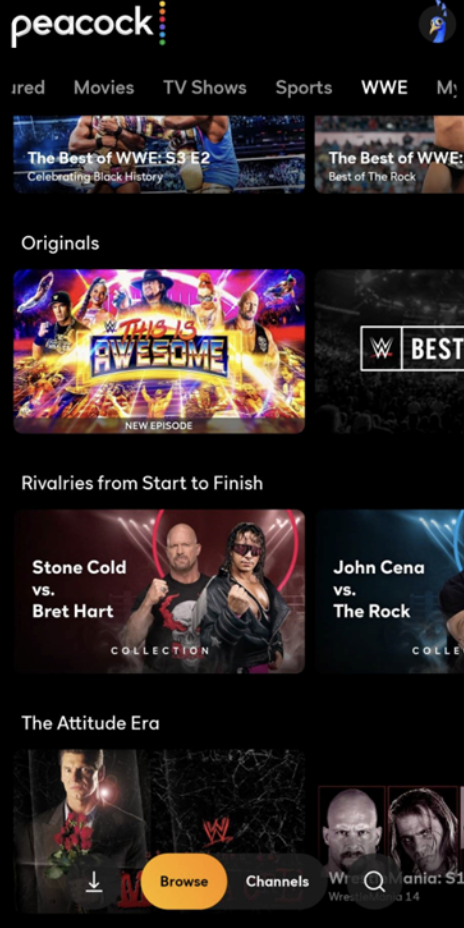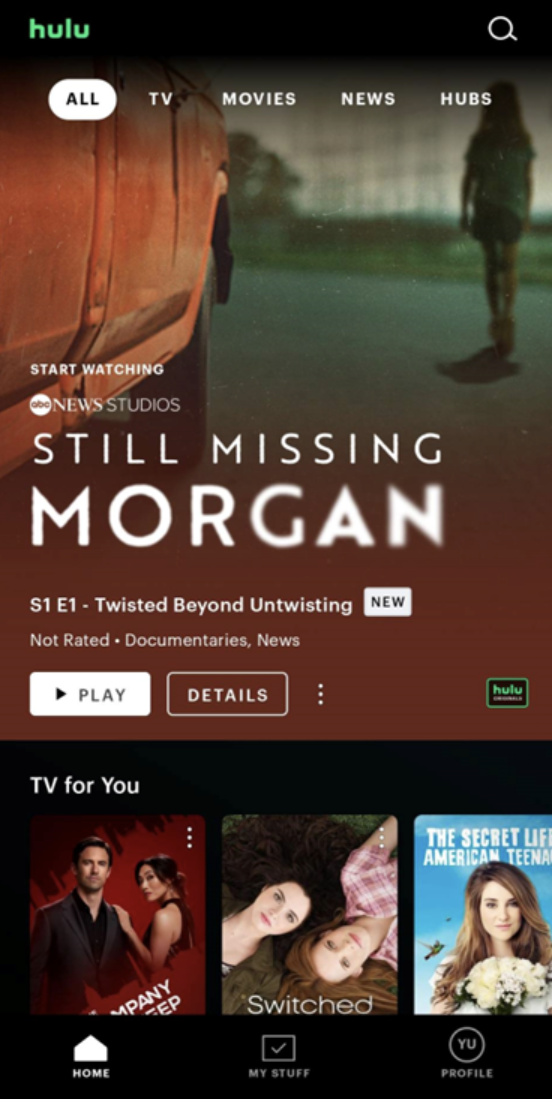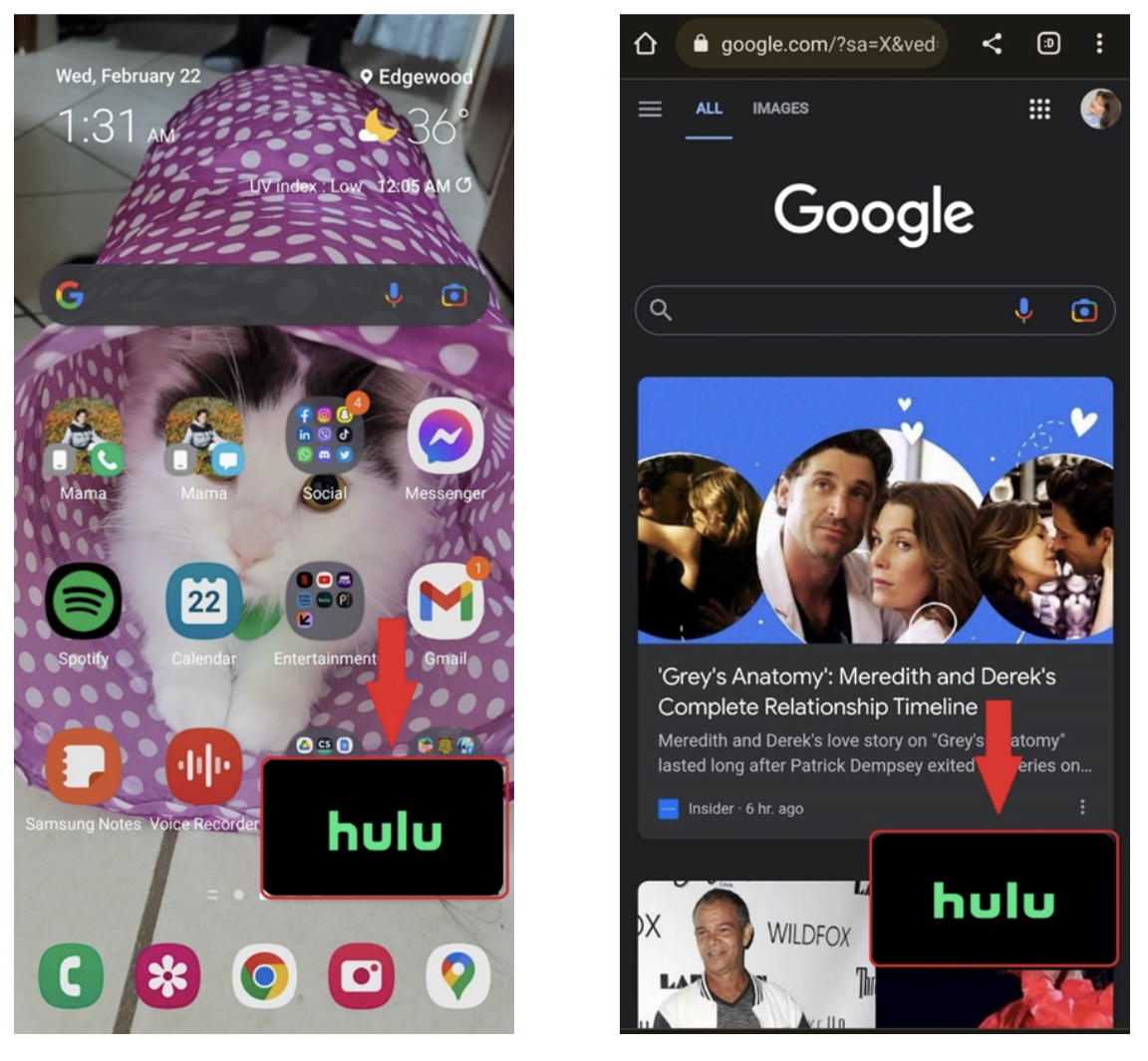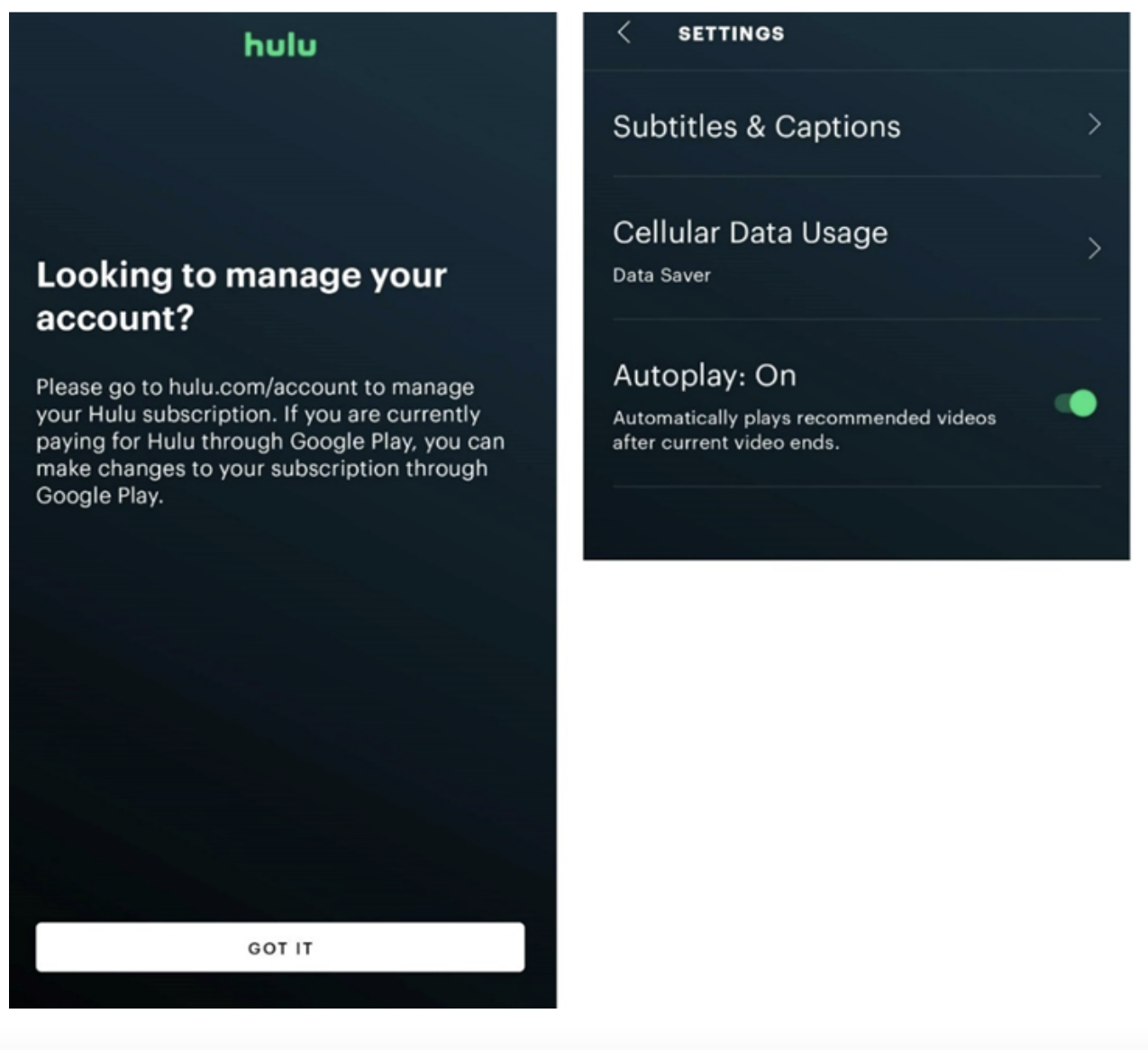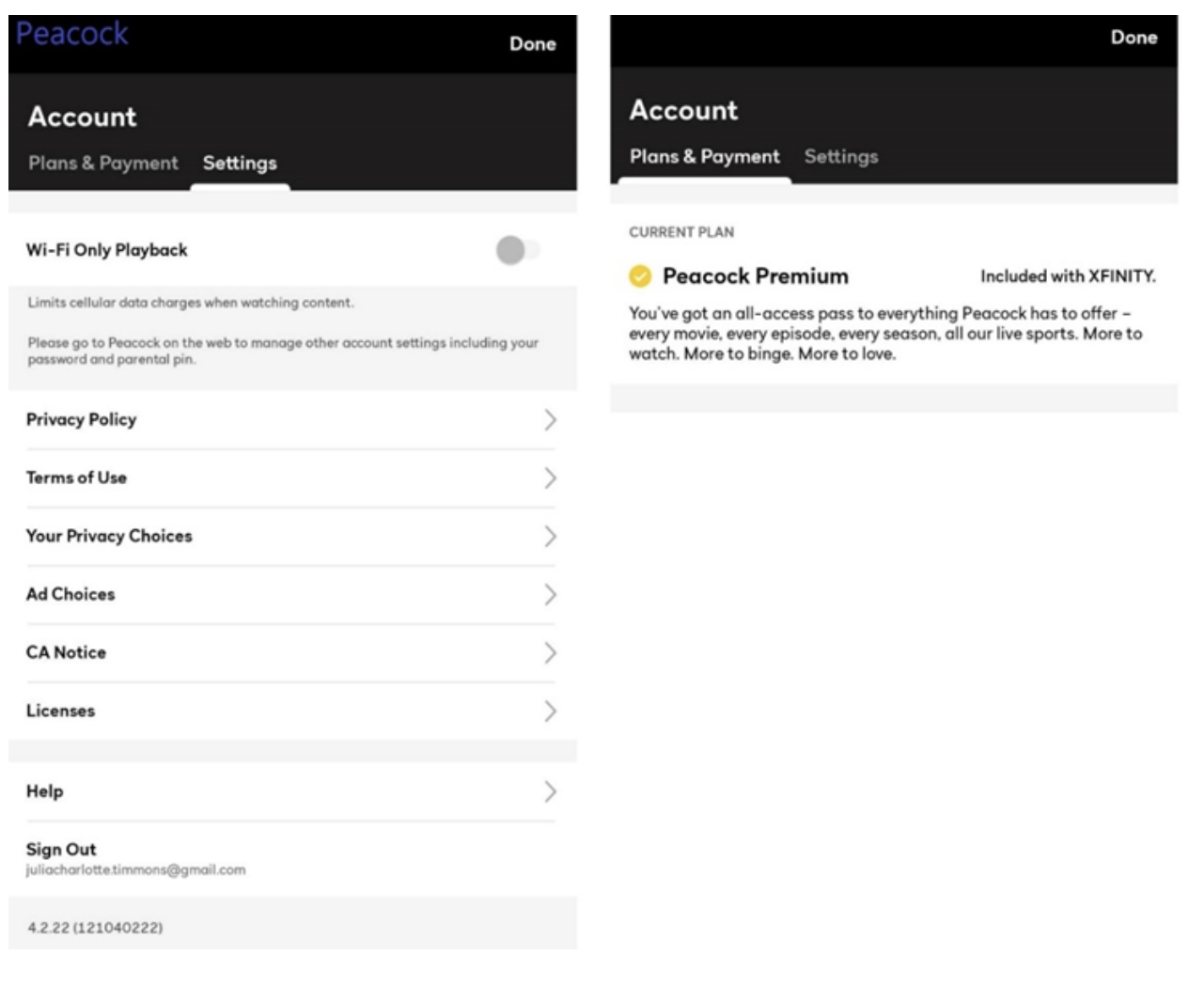by Julia Timmons
As more and more people rely on streaming services and more arts organizations are creating streaming offerings, it is increasingly important to consider user experience beyond a television or larger screen interface. The concept of non-cable TV streaming is now being implemented by almost every traditional network in addition to other streaming-only companies. Clearly, there is a demand and a value to distributing content for the producer as well as the consumer.
To understand the mobile opportunity, I will compare just two of these platforms, Peacock, owned by NBCUniversal, and Hulu, newly acquired by Disney. In order to get the most accurate comparison, I explored the lowest subscription plans, priced at $4.99 for Peacock Premium and $7.99 for Hulu. Both subscriptions are described as “ad-supported unlimited access to libraries.” Both platforms also offer more expensive subscriptions that include additional perks, detailedlater. (Hulu, Peacock)
Content
The quality of each streaming library creates demand; hence, it is important to consider the content available on each platform. Peacock, which is owned and run by NBC Universal, offers TV shows, movies, news, and sports. Peacock subscribers have access to nearly every TV show, news report, and sports event that NBC has ever filmed. Peacock also uniquely offers a plethora of WWE content, which is not exclusive to Peacock, but conveniently centralized as its own category within the platform’s main dashboard. NBC Universal and its subsidiaries play a large role in the film industry, including in the creation of movies, many of which get initially released in theaters. In a 2021 press release, “NBCUniversal committed to adding the “majority” of films from Universal Pictures, Focus Features, Illumination, and DreamWorks Animation Films to its Peacock streaming service as soon as 45 days after they hit theaters” (TheVerge.com). So far, it seems, they have kept true to this promise; as soon after the October 2022 release of the film “Ticket to Paradise” I was able to watch it from the comfort of my bed instead of making my way to my local AMC, paying upwards of $15 to see it. Finally, like many streaming platforms, Peacock offers exclusive access to Peacock Originals. These are shows and films that are produced with the sole intent of release on Peacock and are ONLY available to paying subscribers regardless of tier.
Figure 1. Screen shot of Peacock’s content on mobile. Source: Author.
Hulu differs largely from Peacock in terms of content. The main reason being that while Hulu is owned by Disney, that doesn’t mean that Hulu only offers Disney-owned content. Instead, Hulu has contracts with various networks to stream their content. For example, Hulu has contracts with NBC, CBS, BBC America, and other non-Disney-owned networks. It’s important to note, however, that many non-Disney-owned titles are only available to higher-tier subscribers, who are ultimately paying more. Despite Hulu’s lack of access to non-Disney titles, they have significantly more reach to other networks, namely ABC, freeform, FOX, Lifetime, etc., because those are all subsidiaries of the Walt Disney Company. Hulu’s main dashboard, much like Peacock’s, has categories such as TV, movies, and news. The majority of Hulu’s news offerings are ABC News broadcasts. Hulu also offers an immense number of Hulu Originals, which like Peacock Originals, are exclusive to Hulu subscribers. Hulu, however, has a much larger reach, larger budgets, and more high-profile originals. One example is the “Keeping Up with the Kardashians” spinoff: “The Kardashians.” Hulu Originals also sport popular TV shows such as “The Act,” “The Handmaid’s Tale” and countless more.
Figure 2. Screenshot of Hulu’s content on mobile. Source: Author.
User Interface and Experience
For the most part, the user interfaces of both Peacock and Hulu are similar. Locating desired titles is quick and simple via the search functions. Both platforms offer suggestions based on your viewing history and make picking up where you left off on previously started titles simple. Hulu and Peacock also allow for unlimited profiles if one account is being used by multiple people.
For the purposes of this article, I will focus primarily on the mobile apps for these platforms. Both platforms offer mobile apps for Android and iOS.
In terms of user experience, Peacock and Hulu have some distinct differences.
Multitasking
Peacock is not a multitasking-friendly app. This means that users cannot minimize the screen in the corner to use other apps while watching a title. In order to watch anything on Peacock, it must be full screen at all times. The two photos below illustrate how one can multitask on their phone while having a title running in a small window on the screen in Hulu. The screenshots were taken while running Hulu on an Android device. This functionality allows users to browse other apps, social media, or play games while the TV show or film plays in a smaller window, placed wherever it's most convenient for the user. I tend to put mine in the bottom right-hand corner, as shown in the images below.
Figure 3. Multi-tasking in Mobile with Hulu. Source: Author
Account Management
Neither Peacock nor Hulu allow users to manage their account and subscriptions within the Mobile Apps. Account changes must be done on the website via a standard web browser. This can be done on mobile, but only if accessed through a web browser such as Safari or Chrome. The easiest way to make account changes is on a laptop or desktop browser.
Peacock does, however, show you some account information and offers one modifiable setting. Hulu offers a few app settings but no account info. As you can see in the images below, upon clicking on “account” in the mobile app, both the Hulu and Peacock mobile apps direct users to their respective .com sites to make any changes. In the “settings” section of the Apps, Hulu offers more customizations than Peacock.
Figure 4. Hulu’s Account Settings on Mobile. Source: Author.
Figure 5. Peacock’s Account Settings on Mobile. Source: Author.
Advertisement
Peacock and Hulu have multiple tiers of subscription. The lowest of each tier is ad-supported access to each platform’s libraries. “Ad-Supported” refers to there being video advertisements that play intermittently throughout whatever the user is watching. When watching TV shows on both Hulu and Peacock, there are about 5 ads evenly dispersed throughout the episode. These ads range from 30 – 90 seconds. When it comes to movies, however, Hulu and Peacock treat ads differently. When starting a movie on Peacock, users are shown about 3 minutes of Ads before the actual movie begins. Once the movie starts, there are no more ads.! When watching movies on Hulu, users see an ad at the beginning and two more in the first half of the movie. After the first half, there are no more ads. All three movie ads on Hulu range in the 30 – 90 second range. The final way to encounter an ad on either platform is only applicable to Peacock, and is a fairly new addition to the platform. Whenever users pause any title, the screen transitions to a still image advertisement. This add goes away as soon as the user hits play.
The Peacock app can be pretty glitchy at times in terms of remembering where a user stopped watching if they happen to be mid-episode. This gets extremely frustrating when a user returns and the episode restarts from the beginning, as Peacock does not allow the user to scroll through the episode to find their place without watching each ad that they “skip” along the timeline. Hulu doesn’t have this problem, if you fast-forward to a part of a title that is past an ad break, the ad will be omitted.
Cost
Once upon a time, not too long ago, people found themselves abandoning cable for the more affordable and convenient option: streaming. Now, due to the current abundance of platforms and subscription options, customers are facing the same costs of cable but with more subscription management on their part. With competition for customers increasing and the overall market becoming more saturated, producers began offering a diversified pricing model. Most streaming platforms now have bundle deals and discounted subscriptions.
Peacock is affordable. The lowest-tier subscription is actually free. The free subscription comes with limited access to Peacock’s libraries. Peacock offers two tiers of paid subscription: Peacock Premium at$4.99/month (ad-supported full access) and Peacock Premium Plus at $9.99/month (full access, ad-free, watch offline). Currently, Peacock does not offer any incentive to subscribers who commit to a whole year of service. Peacock does, however, offer Xfinity customers free premium accounts, which makes sense as Xfinity is a subsidiary of Comcast, which is owned by NBC Universal.
Hulu offers more options and more ways to bundle deals. Hulu’s ad-supported plan costs $7.99/month however, they do offer an incentive if you purchase an entire year. A year of ad-supported Hulu costs $79.99 compared to the $96 one would pay if paying month to month. Hulu with no ads costs $14.99/month, and there is no incentive offered if one commits to the whole year. Hulu does offer a large student discount. Students can get ad-supported Hulu for only $1.99/month. Furthermore, Hulu is partnered with Spotify offering free access to ad-supported Hulu with a Spotify Premium subscription for $9.99/month. Furthermore, being owned by Disney comes with its perks. Subscribers who bundle other Disney-owned streaming platforms (ie: Disney Plus, ESPN+) with Hulu can get two or more for the price of one. Hulu is also partnered with non-Disney-owned platforms to offer bundles with substantial savings, then paying for each platform individually. Hulu also offers live TV subscriptions, but those come with substantial price increases and are not the focus of this article.
CONCLUSION
Overall the platforms offer very different content and are in direct competition for customers based on that alone. However, consumers are increasingly sensitive to inconvenient user interfaces, which could turn them off from renewing their subscriptions. Ultimately, the driving force of getting a subscriber comes from content. Keeping them there continues to be informed by content, but a weak user interface can easily drive someone away out of frustration.


